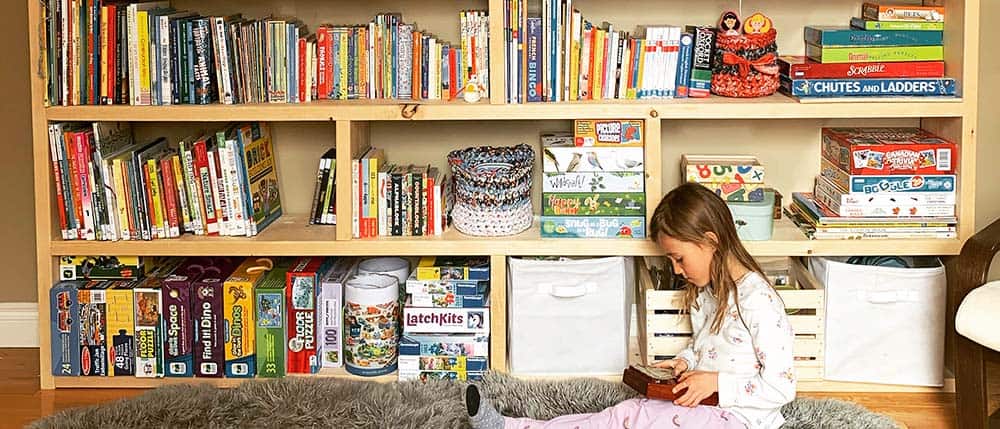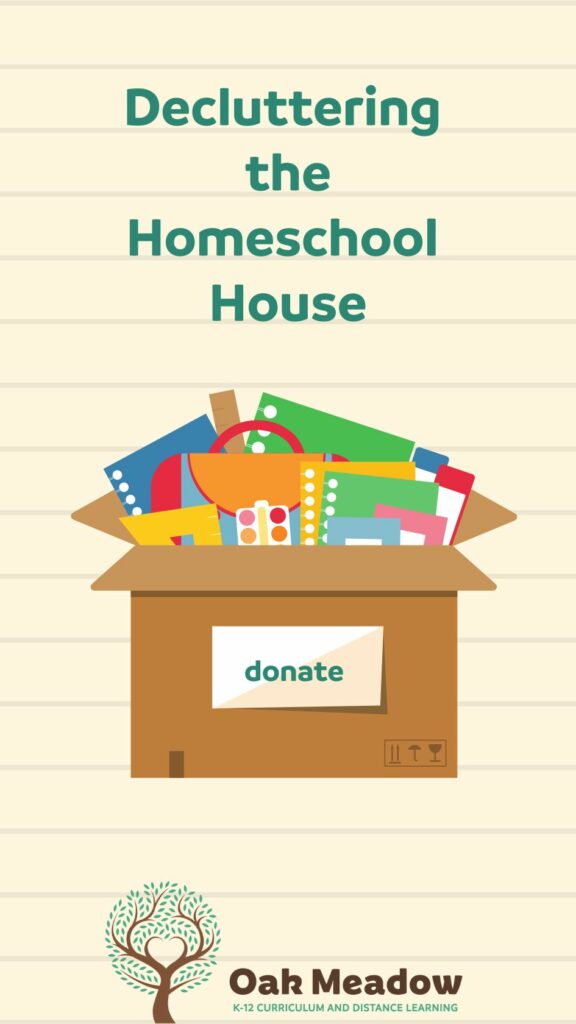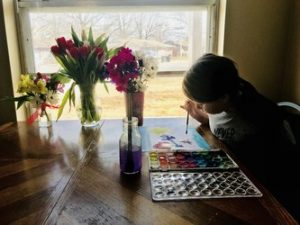
Homeschoolers usually spend a significant portion of their days at home. The many hours of projects, crafts, meals, and experiments that happen every day in a homeschooling house can add up to a significant amount of clutter and chaos. What are some ways to keep your home and your family from getting overwhelmed by this?

Set Up Spaces for Easy Clean Up
One key to keeping your homeschooling space tidy and functional is to set things up so it’s easy to clean up and start over when space is needed for another project. This means having a designated spot for everything, from pencils and paper to art supplies and science equipment. Consider using bins or baskets to corral smaller items, and shelving or cabinets to store larger items. Don’t forget to label everything so it’s easy to find what you need when you need it.
In addition to having a place for everything, it’s important to have a storage area nearby for works in progress. This could be as simple as a folder or binder for each child, or it could be a more elaborate system with labeled containers for each subject or project. Having a designated spot for works in progress will help keep your homeschooling space organized and minimize clutter.
Finally, make sure you have a safe spot for anything that might need to air-dry, such as wet paintings or science experiments. Consider setting up a drying rack or using a designated table or countertop for these items. This will help prevent accidental spills or damage to your homeschooling materials.
Observe Your Family’s Patterns
 How are family members using the space? Where do piles of things usually grow? One of the biggest challenges in any house is keeping things up off the floor. Where do things most often get dropped? If you have a perpetual pile that grows unbidden in a particular place, it’s a sure sign that those items need a permanent home nearby. Put baskets for hats and mittens near where coats are hung. Unfinished works of art may need a shelf near the crafts area.
How are family members using the space? Where do piles of things usually grow? One of the biggest challenges in any house is keeping things up off the floor. Where do things most often get dropped? If you have a perpetual pile that grows unbidden in a particular place, it’s a sure sign that those items need a permanent home nearby. Put baskets for hats and mittens near where coats are hung. Unfinished works of art may need a shelf near the crafts area.
Get Everyone Involved in Clean Up
Who is responsible for tidying up and when? Setting aside regular time once or twice each day for routine clean-up can help keep the clutter from growing. You may find it helpful to assign a container to each family member—a basket, bin, or box—where anyone can deposit items belonging to the owner. Put trash and recycling containers in every room where waste is generated.
Donate or Recycle Often
Make it a habit to weed out and discard unwanted items on an ongoing basis. This is especially true for homeschool curriculum materials, which can be quite costly and may be of use to other families in your community. Things that are broken should be fixed or discarded. Papers can often be recycled. If you feel overwhelmed, just deal with the pile or item that you bump into first—then repeat, repeat, repeat.
 If your children have a hard time decluttering, make it a game: “Keep or Don’t Keep?” See how fast you can sort through a pile together. Start with two containers for sorting things into—one “keep” bin and one “toss” bin. Hold up each item in turn and ask dramatically, “Keep? Or don’t keep?” Encourage your child to respond as quickly as possible for each item. Time yourselves if it adds to the excitement. When the pile is gone, you can whisk the “toss” pile out of sight to minimize a change of heart.
If your children have a hard time decluttering, make it a game: “Keep or Don’t Keep?” See how fast you can sort through a pile together. Start with two containers for sorting things into—one “keep” bin and one “toss” bin. Hold up each item in turn and ask dramatically, “Keep? Or don’t keep?” Encourage your child to respond as quickly as possible for each item. Time yourselves if it adds to the excitement. When the pile is gone, you can whisk the “toss” pile out of sight to minimize a change of heart.
You may also want to reach out to local homeschool groups or co-ops to see if they have any need for materials. You can also check with local libraries, schools, or community centers to see if they accept donations of homeschool materials.
Another option is to donate to online resources such as Homeschool Classifieds or Facebook groups dedicated to buying and selling homeschool materials. Additionally, many online marketplaces such as Amazon or eBay allow you to sell used homeschool materials, so you may be able to recoup some of your expenses while still helping out other families.
Are there places where clutter frequently collects? Consider adding:
- Hooks to hang things on
- Shelves to put things on
- Bins and drawers to put things in
- Baskets, containers, crates to organize things
- Furniture with doors and drawers to help to keep clutter hidden
Make sure storage is at the right height for the people who will use it. If you have young children, store off-limits items on the highest shelves or behind cabinet doors and “help-yourself” items, such as toys and basic drawing supplies, within easy reach. Storage that is too difficult to access will not be used; the same is true for storage that is not in the area where its items are most likely to be abandoned. Try to make it as convenient as possible.
Consider turning a closet or cabinet into a storage space for art and craft supplies and other homeschooling materials. Sort by category and assign one bin or box to each category (crayons, ribbons/string, paint, knitting, etc.). Label everything clearly so that everyone can see what to store in each bin without having to open it to check. Use pictures or symbols if you have family members who are very visual or not yet reading.
With a proactive approach and some practice, managing clutter can become a regular part of your family’s homeschooling routine. Involve everyone in the family in the process and the results will be worth the effort as you enjoy a calmer, less cluttered home.